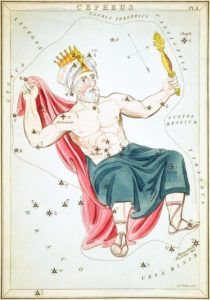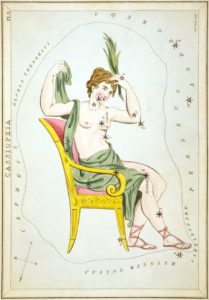Love Written in the Stars – Did James Thornhill Hide a Celestial Secret in the Painted Hall Ceiling?
Thu 8 Feb 24
William III and Mary II, founders of the Royal Hospital for Seamen at Greenwich were the first and only co-monarchs of England, Scotland, and Ireland. They came to power in 1689 after the Glorious Revolution, which deposed James II, Mary’s father from the throne, and they ruled together until Mary’s death from smallpox in 1694. This well-known royal couple is depicted right at the heart of Sir James Thornhill’s Painted Hall Ceiling, surrounded by the constellations which make up the twelve signs of the Zodiac.
Thornhill began the painting in 1707, five years after William’s death, but is it possible that he may have included a secret reference to a different King and Queen who reigned in splendour in the starry heavens?
Cepheus & Cassiopeia

Image credits: Cepheus and Casssiopeia by Sidney Hall, 1825. Library of Congress.
The constellation Cepheus is named after a king in Greek mythology who was the husband of Cassiopeia and the father of Andromeda. This constellation is located in the northern sky near the Pole Star and can be seen throughout the year from the Northern Hemisphere. Cepheus is usually depicted as a robed king with his arms outstretched, with sceptre extended towards Queen Cassiopeia.
Similarly, the robed King William on the Painted Hall Ceiling stretches out his arms to receive the olive branch from the figure of Peace, whilst simultaneously handing the cap of liberty to the female figure of Europa. As the king’s hands are fully occupied, his sceptre is held by Cupid, the son of Venus and God of Love and Desire, who points it in the direction of Queen Mary.

The large constellation Cassiopeia is also found in the Northern skies, in close visual proximity to Cepheus. Cassiopeia is named after the Queen of Aethiopia (Ethiopia), wife of King Cepheus, known for her beauty but also her vanity. According to Greek legend she was made an example of by the God of the Sea, Poseidon, who punished Cassiopeia by placing her in the sky, obliging her to spend half of the time in an uncomfortable upside-down position.
The constellation is one of the most easily recognisable in the night sky as the five brightest stars form a letter W known as the Celestial W, representing Cassiopeia on her throne. As she orbits around the Pole Star and turns upside down, the W becomes the Celestial M or Lazy M.
A Celestial Secret Unveiled
Is it just a coincidence that W is the first letter of William and M the first letter of Mary? Take a closer look at Queen Mary seated on her throne and you can see that the palm frond traditionally held by Cassiopeia which signifies victory or peace, has been replaced by the olive branch, which is also associated with peace. As the branch is handed to King William, his arm and that of Peace herself, form the shape of the Celestial W in front of Queen Mary.
For centuries, sailors and adventurers looked up to the heavens, using constellations such as Cassiopeia to navigate the seas and oceans. When Sir James Thornhill produced his first designs for the Painted Ceiling, only King William appeared in the central oval. But the concept of a royal hospital for injured and retired naval veterans was Mary’s. When she died, William was devastated and distraught at her loss. In a passionate response to acknowledge her devotion to the project, William backdated the charter for the Hospital to a time shortly before her death.
Most of the characters and symbols painted on the ceiling are ingrained with multiple meanings and significance, which goes to show that Thornhill certainly had a great understanding of astronomy as well as a Greek and Roman mythology. So, is it possible that he saw the parallels with the royal couple’s astral counterparts and changed his composition accordingly, to have them looking down together from the heavens? Has Sir James Thornhill provided us with clues to a hidden celestial secret?
We can but hope that one day, if all our stars are in alignment, the truth will finally come to light. In the meantime, why not celebrate this Valentine’s Day with a delicious afternoon tea and a visit to admire Thornhill’s masterpiece?
Written by Simon Davies


